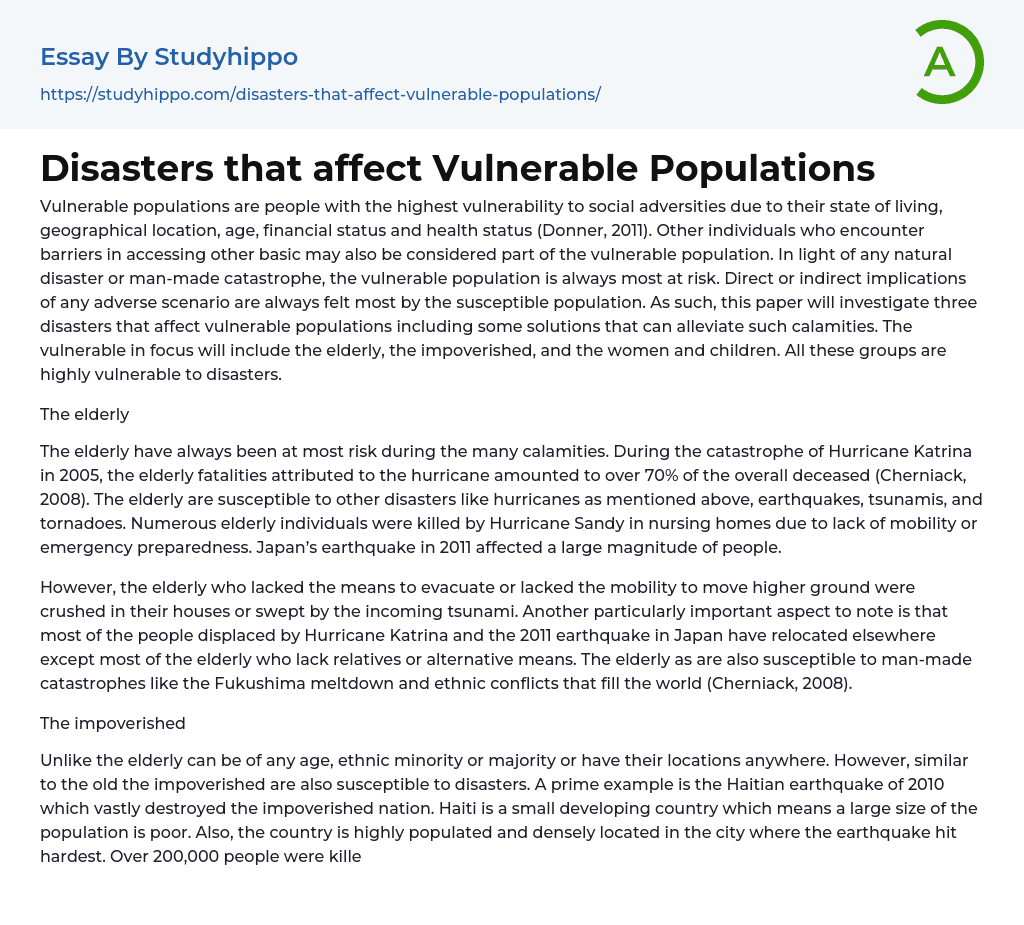

Disasters that affect Vulnerable Populations Essay Example
Vulnerable populations are people with the highest vulnerability to social adversities due to their state of living, geographical location, age, financial status and health status (Donner, 2011). Other individuals who encounter barriers in accessing other basic may also be considered part of the vulnerable population. In light of any natural disaster or man-made catastrophe, the vulnerable population is always most at risk. Direct or indirect implications of any adverse scenario are always felt most by the susceptible population. As such, this paper will investigate three disasters that affect vulnerable populations including some solutions that can alleviate such calamities. The vulnerable in focus will include the elderly, the impoverished, and the women and children. All these groups are highly vulnerable to disasters.
The elderly
The elderly have always been at most risk during the many calamities. During
...the catastrophe of Hurricane Katrina in 2005, the elderly fatalities attributed to the hurricane amounted to over 70% of the overall deceased (Cherniack, 2008). The elderly are susceptible to other disasters like hurricanes as mentioned above, earthquakes, tsunamis, and tornadoes. Numerous elderly individuals were killed by Hurricane Sandy in nursing homes due to lack of mobility or emergency preparedness. Japan’s earthquake in 2011 affected a large magnitude of people.
However, the elderly who lacked the means to evacuate or lacked the mobility to move higher ground were crushed in their houses or swept by the incoming tsunami. Another particularly important aspect to note is that most of the people displaced by Hurricane Katrina and the 2011 earthquake in Japan have relocated elsewhere except most of the elderly who lack relatives or alternative means. The elderly as are also susceptible to man-made catastrophes
like the Fukushima meltdown and ethnic conflicts that fill the world (Cherniack, 2008).
The impoverished
Unlike the elderly can be of any age, ethnic minority or majority or have their locations anywhere. However, similar to the old the impoverished are also susceptible to disasters. A prime example is the Haitian earthquake of 2010 which vastly destroyed the impoverished nation. Haiti is a small developing country which means a large size of the population is poor. Also, the country is highly populated and densely located in the city where the earthquake hit hardest. Over 200,000 people were killed in the earthquake and its subsequent aftermath. (Donner, 2011) Most of the fatalities were felt in the slums and poor neighborhoods where the structures were not build to withstand earthquakes.
Today, a large portion of the displaced population lives in camps due to lack of any means to move or rebuilt again. The poor are also at risk for disasters like famine, epidemics and pandemics due to their locations in informal settlements. Most of the world’s poor population dwell in urban areas that where health facilities and infrastructures are poorly organized. As such, the impoverished are susceptible to famine, droughts, diseases, and earthquakes.
The women and children
The women and children are always considered to be more sensitive to risk than boys and men. While there are claims that women have a larger tolerance for risk and are better suited to respond, statistics indicate otherwise. Women, especially single women are relatively poorer than men. Such adversities ensure women are more likely to suffer a natural disaster. For example, the Katrina highlighted the plight of women when it was discovered they suffered more fatalities
than men and boys. Also, tradition social roles for women like secondary responsibilities of child care increase their risk in case of disasters. Women and children are susceptible to earthquakes, diseases, tsunamis, hurricanes and famines (donner, 2011).
Solutions for vulnerable populations
Building a more resilient vulnerable is an objective that should be undertaken by every stakeholder in the society. One particular aspect that needs to be controlled is the population explosion. Population increase expands the risk for the vulnerable population. In addition, the people should move to ensure policy makers and the government enact more policies that lay steps to prevent adverse effects of disasters on the vulnerable population. Such policies should also emphasize representation for the misrepresented vulnerable populations. Developing elaborate and efficient communication and alert systems will also aid vulnerable people like the elderly and disable prepare. Also, organizations should ensure when disaster strikes that disaster-related assistance is accessible to the impoverished.
References
- Cherniack, E. (2008). The impact of natural disasters on the elderly. Am Journal disaster Med, 3(3) 133-9.
- Donner, W. (2011, January). Disaster Risk and Vulnerability: The Role and Impact of Population and Society. Retrieved from Population Reference Bureau: http://www.prb.org/Publications/Articles/2011/disaster-risk.aspx
- Field essays
- Cuba essays
- Haiti essays
- Jamaica essays
- Puerto Rico essays
- Abolitionism essays
- Adam Smith essays
- American History essays
- American Revolution essays
- Ancient Egypt essays
- Articles Of Confederation essays
- Atlantic Slave Trade essays
- Aztec essays
- Benjamin Franklin essays
- Civil Rights Act of 1964 essays
- Civil Rights Movement essays
- Civil war essays
- Cleopatra essays
- French And Indian War essays
- Gettysburg essays
- Great Depression essays
- Hurricane Katrina essays
- Industrial Revolution essays
- Jamestown essays
- Manifest Destiny essays
- Mccarthyism essays
- Patrick Henry essays
- Pearl Harbor essays
- Pocahontas essays
- Prohibition essays
- Pyramids essays
- Salem Witch Trials essays
- Slavery essays
- The New Deal essays
- Thirteen Colonies essays
- Westward Expansion essays
- Afghanistan essays
- Africa essays
- America essays
- Asia essays
- Australia essays
- Caribbean essays
- City essays
- Developing Country essays
- Dubai essays
- Earthquake essays
- Europe essays
- Fracking essays
- Georgia essays
- Middle East essays



